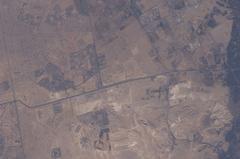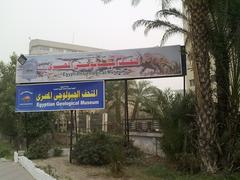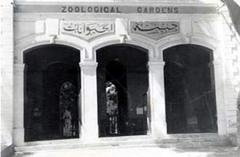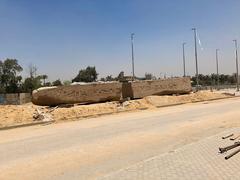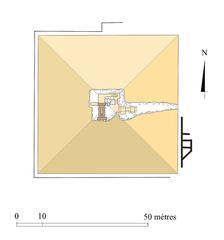
The Great Pyramid of Giza: Visiting Hours, Tickets, and Historical Significance Guide
Date: 03/07/2025
Introduction
The Great Pyramid of Giza is a monumental testament to ancient Egyptian craftsmanship, spirituality, and power. As the sole surviving Wonder of the Ancient World, it draws millions of visitors annually, offering a unique connection to over 4,500 years of history. This comprehensive guide explores the Great Pyramid’s rich heritage, practical visitor information—including updated hours, ticketing procedures, accessibility, and travel tips—and highlights nearby attractions, ensuring a rewarding and well-prepared visit. Whether your interest lies in the mysteries of ancient construction, cultural symbolism, or simply experiencing a world-famous landmark, this guide equips you for a memorable adventure on the Giza Plateau (Britannica; Lonely Planet; The Times).
Table of Contents
- Introduction
- Historical Background
- Visiting the Great Pyramid
- Travel Tips and Nearby Attractions
- Safety and Practical Advice
- Frequently Asked Questions (FAQ)
- Conclusion and Resources
Historical Background
Origins and Construction
Commissioned by Pharaoh Khufu (Cheops) during Egypt’s Fourth Dynasty (ca. 2580–2560 BCE), the Great Pyramid is the most ancient and largest structure on the Giza Plateau. Originally standing 146.6 meters (481 feet) tall and constructed from approximately 2.3 million limestone and granite blocks, it covers 13 acres at its base. The pyramid’s precise alignment with cardinal points demonstrates the Egyptians’ advanced understanding of mathematics and astronomy (Britannica; history.com; egyptmythology.com).
Architectural Features
Although now slightly reduced in height due to erosion and the loss of casing stones, the Great Pyramid remains an architectural marvel. Its sides rise at an angle of nearly 52°, and the monument is aligned perfectly with the four cardinal directions. The pyramid’s interior consists of complex passageways, including the Grand Gallery, King’s Chamber, and Queen’s Chamber, with hidden shafts and corridors that continue to intrigue scholars and visitors alike (Britannica).
Religious and Cultural Significance
Far more than a tomb, the pyramid symbolized the pharaoh’s divine authority and the Egyptian belief in the afterlife. Its shape echoes the benben stone from creation mythology, and its capstone (pyramidion) was likely gilded to reflect the sun, reinforcing Khufu’s association with the sun god Ra. The pyramid complex includes temples, causeways, and subsidiary tombs, functioning as a center for mortuary rituals and spiritual life (dailyhistory.org; egyptmythology.com).
Construction Workforce and Techniques
Recent archaeological discoveries, including the Papyrus of Merer, reveal the use of skilled labor, advanced logistics, and canal systems for transporting stone blocks. Contrary to earlier beliefs, the pyramid was built by a large, well-organized workforce, not slaves, with evidence of worker settlements and detailed construction records (Ancient Code; historyskills.com).
Interior Layout and Discoveries
The Great Pyramid’s north-facing entrance leads to a series of passageways and chambers. Notable features include the King’s Chamber (constructed from massive granite blocks), the enigmatic Queen’s Chamber, and two mysterious shafts. Ongoing research using advanced scanning technologies continues to uncover hidden voids and secrets within the structure (Britannica).
The Giza Pyramid Complex
The pyramid is part of a grand necropolis featuring the Pyramids of Khafre and Menkaure, the iconic Sphinx, mortuary temples, cemeteries, and several museums. Together, these monuments demonstrate the Egyptians’ sophisticated understanding of engineering, astronomy, and religious practice (The Times).
Visiting the Great Pyramid
Updated Visiting Hours (2025)
- General Opening Hours: 8:00 AM – 5:00 PM (October–March); 7:00 AM – 6:00 PM (April–September).
- Note: The pyramids themselves may close daily from 12:00 PM – 1:00 PM for cleaning. Confirm hours before your visit as schedules may change for special events or maintenance (Egypt eVisa; Her Asian Adventures).
Tickets and Purchasing Process
- Where to Buy: Tickets are available onsite at the new visitor center (Great Gate) or online through official Egyptian Ministry of Tourism platforms. Advance booking is highly recommended, especially for entry inside the pyramids, as daily visitor numbers are limited (Kosupa Travel).
- 2025 Ticket Prices (Approximate):
- Giza Plateau entry: EGP 540 (~$17 USD)
- Great Pyramid (Khufu) interior: EGP 900 (~$28 USD)
- Khafre or Menkaure Pyramid: EGP 440 (~$14 USD) each
- Photography permit (tripod): EGP 20 (~$1.20 USD)
- Discounts are available for students, children, and residents (Global Highlights).
Accessibility and Facilities
- New Entrance (2025): The main gate is now on the Cairo-Fayoum road, with a central visitor center featuring automatic ticket machines, exhibits, souvenir shops, restrooms, and VIP lounges (Kosupa Travel).
- Transport on Site: Shuttle buses connect the entrance with major monuments, reducing walking distances and improving accessibility.
- Facilities: Modern restrooms, shaded waiting areas, and information desks are available at the visitor center and near key monuments.
Guided Tours and Events
Licensed Egyptologists and professional guides offer both group and private tours, enhancing your understanding of the site’s rich history. Nighttime Sound and Light Shows provide a captivating retelling of the pyramids’ stories, with tickets available onsite or online (Egyptian Streets).
Recommended Visiting Times & Photography Tips
- Best Times: Early morning and late afternoon offer cooler temperatures, softer light, and fewer crowds—ideal for exploration and photography.
- Photography: Standard photography is allowed outdoors; a permit is required for tripods. Drones are prohibited. The best photo spots are from the southern and western dunes and near the Solar Boat Museum (Earth Trekkers).
Travel Tips and Nearby Attractions
- Getting There: The Giza Plateau is about 24 km (15 miles) from central Cairo. Taxis, rideshare apps, and organized tours are the most convenient options (Messy Bun Traveler).
- Where to Stay: Hotels with pyramid views (e.g., Marriott Mena House, Guardian Guest House) offer stunning vistas and easy access.
- Other Attractions: Don’t miss the Great Sphinx, Solar Boat Museum, Tombs of Nobles, and the upcoming Grand Egyptian Museum.
- Dining: The visitor center and restaurants near the Sphinx provide meals and refreshments, with rooftop options for panoramic views (Earth Trekkers).
Safety and Practical Advice
- Dress: Wear modest, lightweight clothing; cover shoulders and knees for cultural respect. Sturdy shoes, sun protection, and water are essential.
- Hassle Management: Politely decline unsolicited offers from vendors. Book camel or horse rides through reputable sources only (The Intrepid Guide).
- Scams: Confirm prices in advance. Use only licensed guides and official ticket outlets.
Frequently Asked Questions (FAQ)
Q: What are the current visiting hours for the Great Pyramid?
A: 8:00 AM – 5:00 PM (October–March); 7:00 AM – 6:00 PM (April–September). Check for updates before your visit.
Q: How do I buy tickets?
A: Purchase online or at the new visitor center. Book in advance for pyramid interior entry.
Q: Is the site accessible for people with disabilities?
A: The visitor center and shuttle system support wheelchair users; the pyramid interior remains challenging due to narrow passages.
Q: Are guided tours recommended?
A: Yes. Guides provide valuable insights and help manage vendor interactions.
Q: Can I take photos or use drones?
A: Photography is allowed outside; a permit is needed for tripods. Drones are not permitted.
Conclusion
A visit to the Great Pyramid of Giza is a journey through ancient history, engineering mastery, and cultural wonder. With recent improvements—including the new entrance, shuttle system, and enhanced visitor facilities—exploring this UNESCO World Heritage Site is more accessible and enjoyable than ever. Careful planning, advance ticketing, and the right travel tips ensure a seamless, awe-inspiring experience.
For real-time updates, interactive maps, and exclusive offers, download the Audiala app. Explore our related guides on Cairo’s historical gems and follow us on social media for the latest travel inspiration. Embark on your Giza adventure with confidence and curiosity, and witness the marvel that continues to captivate the world.
Visuals and Interactive Elements
- Images: Include high-quality images of the Great Pyramid’s exterior, interior chambers, and panoramic plateau views with descriptive alt tags (e.g., “Great Pyramid of Giza at sunrise,” “Interior passage of the Great Pyramid”).
- Interactive Map: Embed a map detailing the new entrance, shuttle stops, and major monuments.
- Virtual Tours: Link to official virtual experiences where available.
Internal Links
References
- Great Pyramid of Giza, Britannica
- Visiting the Pyramids of Giza: Guide and History, Lonely Planet
- The Egyptian Pyramids, History.com
- What Was the Importance of Pyramids in Ancient Egypt?, DailyHistory.org
- Ultimate Guide to the Pyramids of Giza, The Times
- Important Update for Visiting the Giza Pyramids & Sphinx, Kosupa Travel
- How to Visit the Pyramids of Giza, Global Highlights
- Tourist Guide to Visiting Pyramids of Giza, Egypt eVisa
- Visiting the Pyramids of Giza, Her Asian Adventures
- Age of the Great Pyramid, Travel Pander
- Things to Do in Giza, Egypt Time Travel
- Pyramids of Giza History, World History Journal
- Things to Do in Giza, The Tourist Checklist
- How to Visit Pyramids of Giza, Earth Trekkers
- Top Tips for Visiting the Pyramids of Giza, The Intrepid Guide
- Visiting the Pyramids of Giza: Everything You Need to Know in 2025, Egyptian Streets
- Ultimate Guide to Visiting the Pyramids of Giza in Egypt, Messy Bun Traveler
- Visit the Pyramids of Giza, Find Love and Travel











